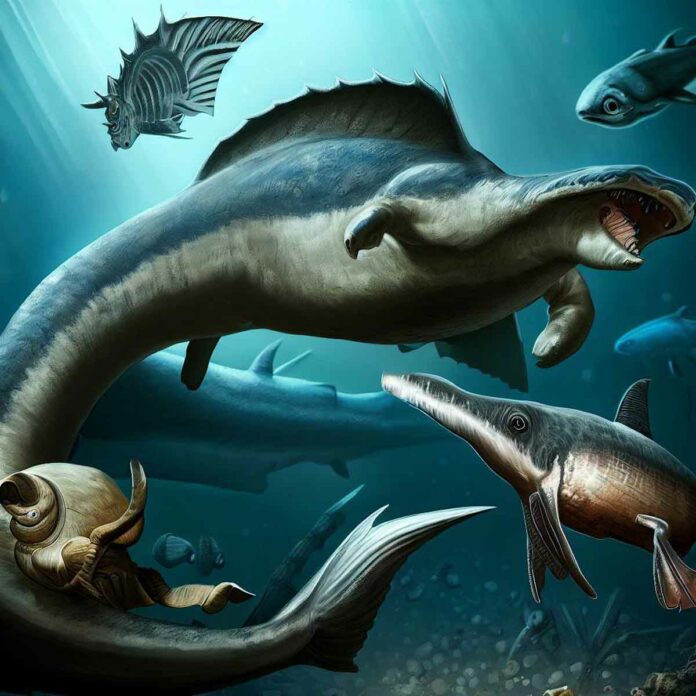Dr. Barry Albright, a faculty member at the University of North Florida, has participated in a research project led by the Bureau of Land Management (BLM), which has resulted in the discovery of a 94-million-year-old mosasaur in the gray shale badlands of the Glen Canyon National Recreation Area in southern Utah.
The mosasaur is an ancient marine reptile that existed during the time of dinosaurs. This groundbreaking find has been published in the journal Cretaceous Research.
The journey began over a decade ago when Scott Richardson, a trained volunteer working with Dr. Albright, began searching for fossilized remains of marine creatures that inhabited a large seaway covering the middle of North America during the Late Cretaceous Period, approximately 84 to 95 million years ago.
In March 2012, Richardson discovered numerous small skull fragments and vertebrae of an early mosasaur scattered across a shale slope.
According to Dr. Albright, "During the deposition of the Tropic Shale around 94 million years ago, mosasaurs were still in their early evolutionary stages of becoming fully adapted to a marine environment. This is why their fossils are extremely rare and difficult to find."
Over the next two field seasons, a joint team from the BLM and the National Park Service managed to recover nearly 50% of the specimen, allowing for its precise identification.
Dr. Alan Titus, a paleontologist from the BLM Paria River District, led the research team, which included BLM staff, volunteers, and Steve Dahl, a volunteer who was later honored in the species name Sarabosaurus dahli, meaning “Dahl’s reptile of the mirage.”
The name references both the ancient seaway where the animal lived, which has long since disappeared, and the mirages commonly observed in the region’s scorching summers.
Dr. Titus explained, "Mosasaurs are relatively abundant in rocks younger than 90 million years, but they are extremely rare in older rocks. Discovering one that preserves such informative data, especially from this time period, is truly a significant find."
Mosasaurs originated as small, three-foot-long creatures but eventually evolved into gigantic marine predators resembling lizard-like creatures.
They thrived in the oceans during the later part of the dinosaur age.
Their ancestors were similar to modern Komodo Dragons, but over time, their aquatic counterparts developed streamlined bodies, paddle-like fins, and tails that propelled them through the water.
Early mosasaurs exhibited a lizard-like appearance, characterized by rudimentary tails and limbs. However, Sarabosaurus stood apart with a unique attribute—a novel mechanism for blood circulation to its brain.
Dr. Michael J. Polcyn from the University of Utrecht, Netherlands, and Southern Methodist University, Dallas, stated, "Sarabosaurus provides insights into the evolution and antiquity of a novel cranial blood supply observed in a particular group of early branching mosasaurid species. It also helps address longstanding questions about their relationship."
In summary, the discovery of the 94-million-year-old mosasaur, named Sarabosaurus dahli, sheds light on the early stages of mosasaur evolution, as well as their unique adaptations and blood circulation.
This finding contributes to our understanding of these ancient marine reptiles and their place in the evolutionary history of life on Earth.
FAQ
A mosasaur is an extinct marine reptile that lived during the Late Cretaceous Period, alongside dinosaurs. These reptiles were fully adapted to marine life and were powerful predators in the ancient oceans.
Mosasaur fossils from rocks older than 90 million years are extremely rare. The discovery of a well-preserved specimen from this time period, such as the 94-million-year-old mosasaur found in Utah, is a significant scientific find.
The research team was led by the Bureau of Land Management (BLM) and included Dr. Barry Albright, a faculty member at the University of North Florida, as part of the team. Dr. Alan Titus, a paleontologist from the BLM Paria River District, played a crucial role in the research.
The mosasaur fossil was found in the gray shale badlands of the Glen Canyon National Recreation Area in southern Utah, within the National Park Service’s jurisdiction.
Over the course of two field seasons, the research team managed to recover nearly 50% of the mosasaur specimen, which provided enough material to accurately identify and study the ancient reptile.
Yes, the species name given to the mosasaur, “Sarabosaurus dahli,” honors Steve Dahl, a volunteer who participated in the research. The name also alludes to the mirages commonly observed in the region’s extreme summer heat and the vanished ancient seaway in which the mosasaur once swam.
The groundbreaking discovery of the 94-million-year-old mosasaur has been published in the scientific journal Cretaceous Research, making it accessible to the scientific community and researchers interested in paleontology and evolutionary studies.
The find provides crucial information about the early branching of mosasaurid species and offers new insights into the evolution and antiquity of specific cranial features, including the unique cranial blood supply observed in Sarabosaurus and related mosasaurs.
The discovery adds to our understanding of the ancient ecosystems that existed during the Late Cretaceous Period and the diversity of marine reptiles that roamed the seas while dinosaurs dominated the land. It provides a glimpse into the complex web of life and the remarkable adaptations that emerged during this time.
More information: Cretaceous Research (2023). DOI: 10.1016/j.cretres.2023.105621

